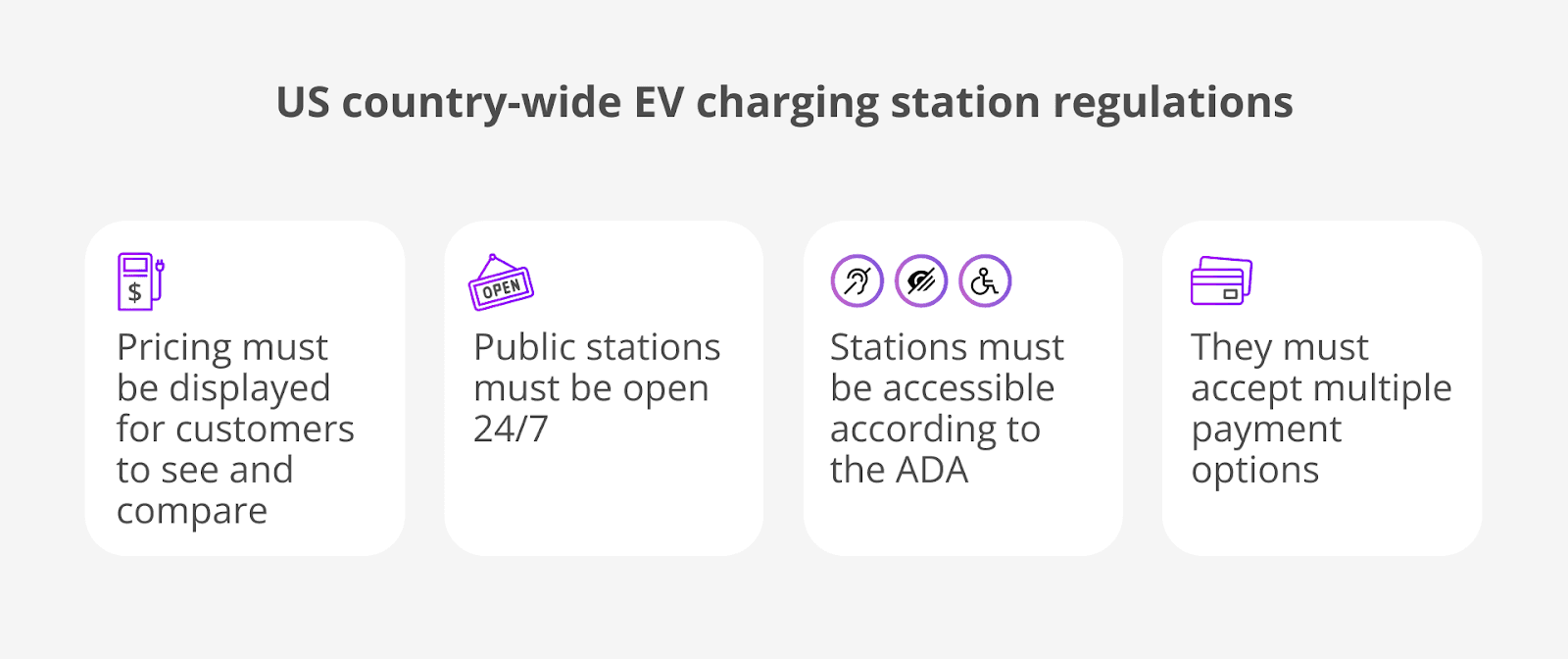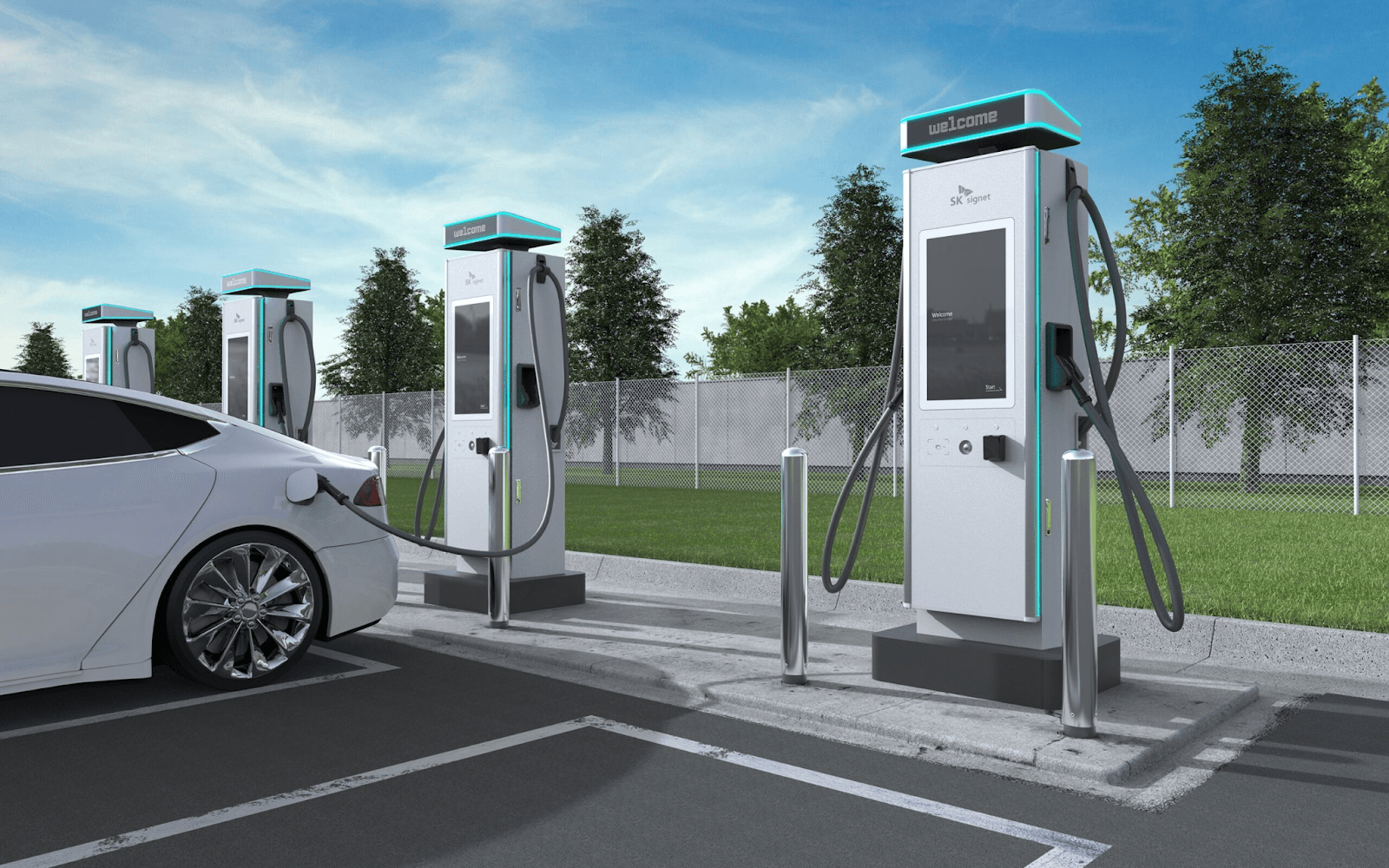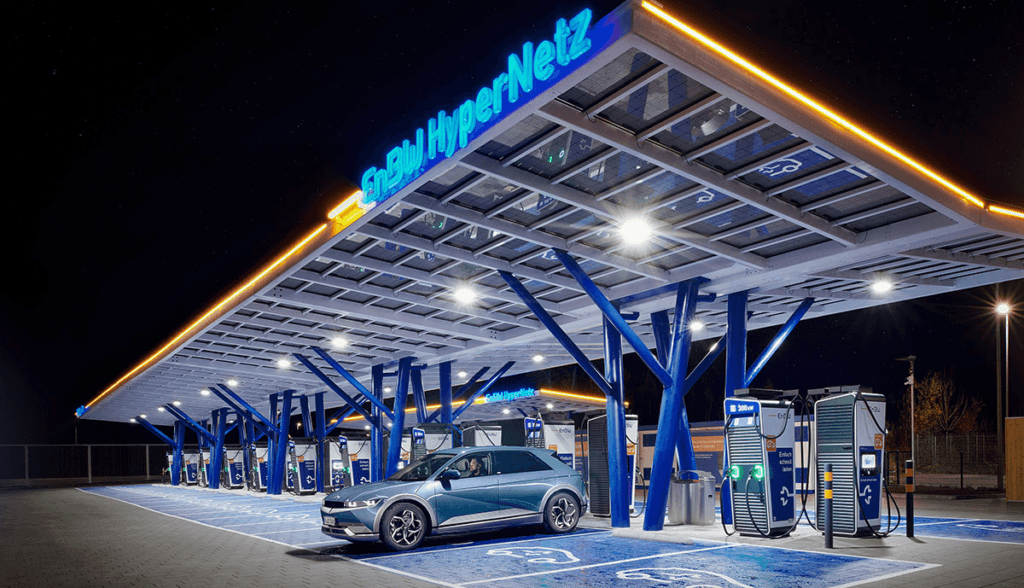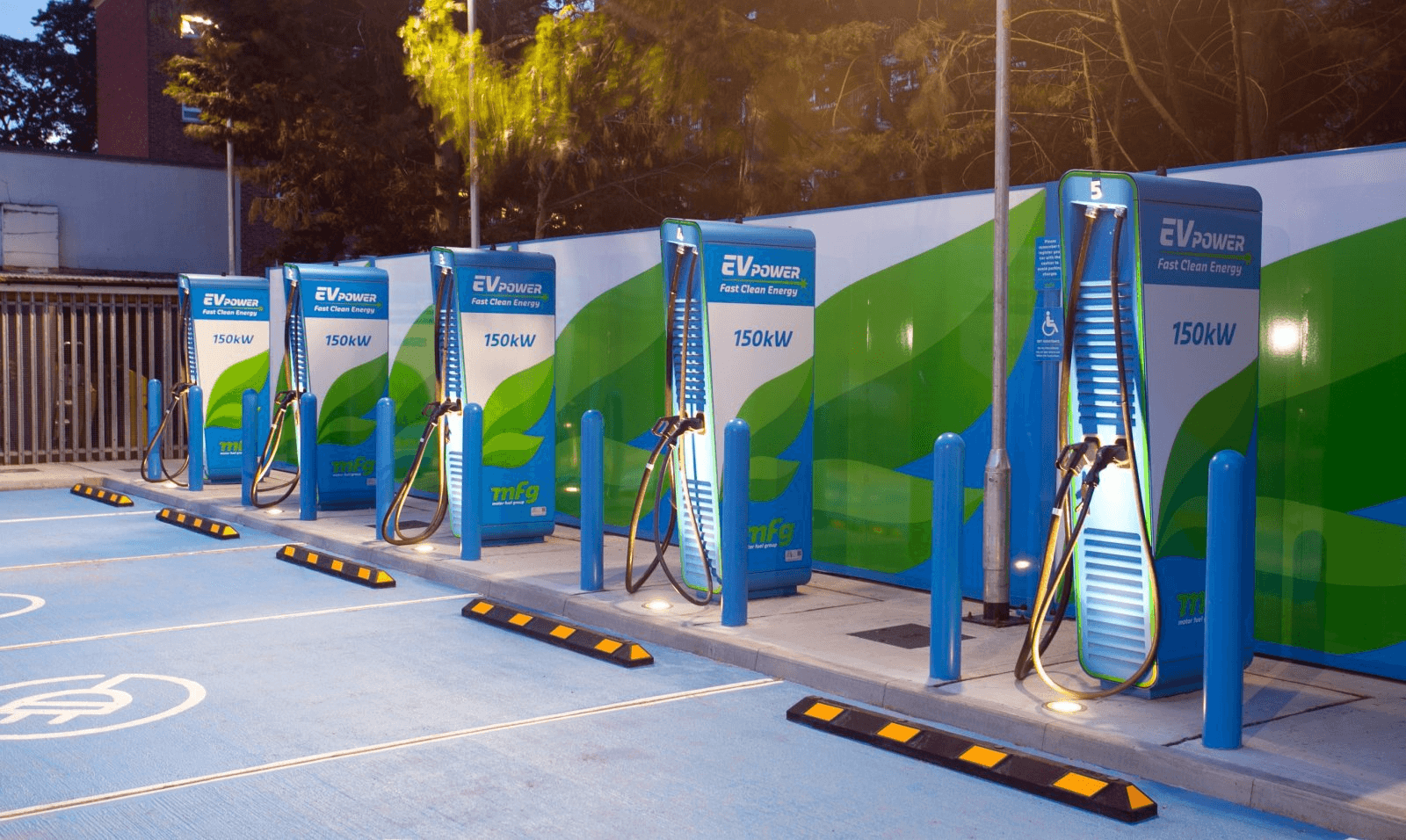Anticipating EV Charging Regulations While Staying on Track
How can you remain compliant with EV regulations as they evolve? Here, we explore the different EV charging station regulatory laws valid in the US, EU, and UK, and share tips to protect your business from infringing them.
Matias Emiliano Alvarez Duran

Back to the Future said we’d have flying cars by 2015. We’re still not there yet, but we do have electrical and self-driving vehicles, which is honestly pretty cool. However, these hit the market before the world had the infrastructure to easily charge them. This has made the development of charging ports and stations a priority for many governments, causing regulations to change over time.
Regulatory compliance is no one’s favorite topic. However, doing it right protects your business from infringing the law and prevents you from getting fines. Regulations also safeguard your customers’ data and support ethical practices.
As a charge point operator (CPO), you’re required to follow local regulatory guidelines to offer customers an equitable experience across stations and prevent putting their data at risk.
Since the industry is relatively new, EV charging station regulatory compliance is in constant change. This means you may have a planned roadmap, and then you get hit with a new regulation. So, to avoid getting fined or delaying your plans, let’s explore how you can stay ahead of the curve without affecting your project’s timeline while staying compliant.
Disclaimer: This article doesn’t give legal advice. You should consult with a specialized lawyer for assistance if you decide to build an EV charging station.
Table of Content
- Current global regulatory framework for EV charging infrastructure
- Technical EV charging ports compliance requirements
- The industry challenge: Meeting those regulations without investment
- How to remain compliant with EV charging station regulations
- How can you build an always-compliant solution with NaNLABS?
- Frequently asked questions about EV charging station regulatory compliance
Current Global Regulatory Framework For EV Charging Infrastructure
Apart from seeking out the right building permits, EV charging stations need to comply with physical and technical regulations. Here are the most important US, European, and UK EV charging station requirements explained.
US federal and state regulations and programs for EV charging spaces

US country-wide EV charging regulations
Although there are unique state-level regulations that you need to follow, most come from the National Electric Vehicle Infrastructure (NEVI) formula. So, you’ll see that the requirements for EV charging station compliance repeat across states.
However, you can find the complete list of EV charging station regulations at a federal or state level on the government’s energy site.
Federal regulations
If you’re in the US, you need to comply with these regulations:
This is a local initiative that funds the development of public EV charging stations across the country. All recipients of this funding need to adhere to these practices:
- EV charging stations must have at least four functional ports that can simultaneously charge four EVs at 150kW per port, with 97% uptime reliability.
- Stations must be located within 50 miles of Alternative Fuel Corridors (AFC) and no further than one mile from the freeway exit. This is also a regulation from the Federal Highway Administration (FHWA) guidelines.
- Stations need to be open 24/7 and publicly accessible to all drivers.
- Companies need to adhere to the Americans with Disabilities Act (ADA). For example, the charging connector handle must be within reach for individuals using wheelchairs. Meaning, the port needs to be placed between 15 inches and 48 inches from the ground.
- All stations need to guarantee the physical security of the equipment and take cybersecurity measures to protect the driver’s integrity and personal information.
- There needs to be open access to multiple payment options without asking users for a subscription or membership.
- Charging stations must be interoperable and compliant with ISO 15118–2 and OCPP 1.6J or higher.
Department of Energy (DOE) standards:
The DOE requires EV charging equipment to support interoperability, safety, and grid integration. It also includes signage and parking regulations, such as:
- EV charging stations must be defined as a public parking area that includes chargers.
- These must have vertical signage identifying the station, it should say that it’s only available for EV charging. “The signage must be consistent with the U.S. Department of Transportation Federal Highway Administration’s Manual on Uniform Traffic Control Devices,” explains the US Department of Energy.
- Each operation must visually display all the involved charges and fees for the user to see.
Utility EV promotion measures:
According to Public Law 117-58, approved back in 2021, all EV charging stations must:
- Be affordable and equitable.
- Offer a great customer experience with EV chargers.
- Generate enough revenue to recover the costs of electricity used in EV chargers.
State- and local-level regulations

EV charging station in the US
There are specific state-by-state requirements; we’re not getting into all 50 states, but here are three of the most relevant ones:
California:
This state has some unique regulations related to green initiatives and certifications. These are:
- Zero-Emission Vehicle (ZEV) program. This is somewhat similar to the NEVI, but it also:
- CTEP certification. Commercial EV charging stations must comply with the California Type Evaluation Program (CTEP). This means they need to test the hardware and software to guarantee communication protocols, charging accuracy, electrical safety, and electromagnetic compatibility.
New York:
All charging stations installed in NY must comply with the NFPA 70, also known as the National Electrical Code (NEC), which includes:
- Listing and labelling charging and supply equipment as shared in the UL 2202 and UL 2594.
- All charging stations need to be accessible, as mentioned in Chapter 11 of the NFPA 70.
- Setting up an emergency electrical disconnect per the NFPA 70 to guarantee the physical safety of customers.
- All EV charging stations must be designed with safety in mind, and parking spaces should include bollards, wheel stops, and cord storage.
Washington D.C.:

Person paying with their phone at an EV charging station
The US capital also has unique regulatory requirements for EV charging stations, including:
- Adding vertical signage that indicates EV charging spaces.
- Displaying the costs and fees for users to see and compare.
- Accepting multiple payment options at an open access point.
- Not requiring users to be members or be subscribed to the station.
- Meeting interoperability standards.
AFIR: European Union regulations

EV charging station with a car charging at night in Europe
Europe has local regulatory compliance guidelines for EV charging stations, ruled by the Alternative Fuels Infrastructure Regulation (AFIR). Key points include:
- Recharging point operators must give customers the option to skip automatic authentication. Instead, they should be able to charge their vehicles either on a one-time basis or through a contract-based option available at that location.
- Starting in 2025, EV charging stations need to be installed every 60 km from the Trans-European Transport Network (TEN-T) core networks and every 60 to 100 km along the TEN-T comprehensive networks.
- The minimum output power should start at 150 kW for small vehicles and 350 kW for trucks.
- The prices must be reasonable and easily comparable. These can’t be discriminatory.
- Customers must be able to see the charge price on display per kWh, per minute, and per charging session.
- EV charging stations need to accept multiple payment options and can’t require users to have a membership or subscription.
- Charging stations must meet accessibility standards for users with disabilities.
- These EV charging points need to connect to a backend software with roaming functionality so EU users can access them seamlessly across the continent.
PCPR: UK regulations

EV charging station for five cars in the UK
The UK's Public Charge Point Regulations (PCPR) are a set of guidelines that encourage EV charging stations to provide customers with a consistent experience across the country. Some requirements include:
- The stations must be easy to locate by the public.
- Users need to be able to pay without hassle at all charge points.
- Charge points need to be reliable and performant (99% of reliability is required for rapid chargers).
- Prices need to be transparent for customers to compare them with other networks.
- It enforces open data requirements, including real-time availability status.
Stations must follow smart charging capabilities to prevent grid overload.
Technical EV Charging Ports Compliance Requirements
We’ve covered all the broad regulatory compliance guidelines for EV charging stations across the globe. But, how does this transform into the hardware and software? Let’s see!
Hardware requirements
Although the regulatory law changes depending on location, most guidelines expect EV charging stations to meet:
- Interoperability standards. Your station should be compatible with multiple vehicles and backend networks and support the Open Charge Point Protocol (OCPP) and OpenADR. These ensure your infrastructure supports communication protocols between systems and allows for seamless communication between the charger, cars, and charging networks.
- Safety requirements. UL 2594, UL 2202, and UL 2231 aren't just alphabet soup, they're critical safety standards for charging equipment. Compliance with these (or local equivalents like IEC 61851 in Europe) helps you avoid potential fires, malfunctions, or legal liability.
- Power and performance needs. Governments expect EV charging stations to be fast and reliable. Some countries, like the UK, expect up to 99% of uptime and support charges starting from 150 kWh or higher. Inconsistent uptime could potentially lead to losing your permits or funding.
- Environmental and energy integration guidelines. Many countries now require EV chargers to use renewable energy directly (e.g., solar carports) or offer smart grid integration for load balancing and demand response.
Software and network requirements
But what needs to happen inside those machines? EV charging stations aren’t just power outlets, they're smart, interconnected systems. So, the software within them needs to meet high standards to ensure operability, security, and user experience. Here’s what that typically involves:
- Supporting multiple payment options. You need software for payment processing that’s in compliance with the PCI-DSS. It also needs to support multiple payment methods like chip cards, contactless payment standards, and multiple currency support for international deployments.
- Meeting data security standards. You need to adhere to the CCPA in California, the GDPR in Europe, the PIPEDA in Canada, and any emerging privacy regulations to keep your data pipeline protected.
- Adopting interoperability protocols. Your backend also needs to comply with the OCPP and OpenADR. It also needs to support multiple protocol versions simultaneously, because the field upgrades never happen as quickly as planned.
- Meeting roaming standards. Your software must comply with the Open Charge Point Interface (OCPI) and eMobility Inter-operation Protocol (eMIP) to enable cross-network charging.
- Enabling remote diagnostics and updates. Getting access to your station data in real-time can help you run real-time diagnostics, over-the-air (OTA) firmware updates, and status monitoring dashboards. This reduces downtime, supports predictive maintenance, and avoids on-site maintenance visits.
- Supporting load management and grid responsiveness. You don’t want your ports to overheat, so your software needs to support smart charging capabilities. This means it should offer load balancing across stations, support vehicle-to-grid (V2G) and demand-response integration, and communicate with grid operators to shift loads during peak hours.
The Industry Challenge: High Expectations, Low Support
The U.S. EV charging infrastructure is stuck in a tricky loop. On one hand, federal regulations are pushing for ultra-high performance: a 97% uptime requirement for charging stations. On the other hand, recent political shifts have pulled back public funding, leaving Charging Point Operators (CPOs) to carry the cost of meeting those standards.
But here's the issue: Without reliable infrastructure, EV adoption slows down. And if fewer people are buying EVs, there's less incentive for private investors to build new stations or upgrade existing ones. It’s a vicious cycle. The demand isn’t growing fast enough because the infrastructure isn’t there, and the infrastructure isn’t improving because the demand isn’t justifying the investment.
For CPOs, this creates a high-stakes environment: they’re expected to meet strict uptime regulations with limited financial backing, all while trying to convince a cautious market that EVs are still worth it.
Why the Uptime Requirement Is a Major Hurdle for CPOs
Meeting a 97% uptime requirement means that charging stations must be operational nearly all the time. That sounds great on paper, but the grid isn’t there yet, for several reasons:
- Infrastructure limitations: Many of the existing charging stations are built on older or less reliable grid systems that may struggle to meet such high reliability standards. In some cases, the grid infrastructure itself can be a bottleneck, especially in rural or underserved areas.
- Maintenance and Repairs: Charging stations require regular maintenance and occasional repairs. Achieving 97% uptime means that these stations must be up and running virtually all the time, which can be hard to guarantee when unexpected breakdowns happen or when equipment needs upgrading.
- Remote locations and low traffic: Many charging stations are located in less-traveled areas where usage is sporadic. The lower volume of users means that it’s harder for CPOs to justify the significant investment in high-tech, high-reliability systems that could reduce downtime.
- Financial burden: Ensuring such high uptime comes with a hefty price tag. From investing in reliable equipment to paying for on-the-ground technical support and infrastructure updates, the costs quickly add up. And without guaranteed demand, investors are less likely to fund this costly infrastructure.
Navigating the Challenge: Practical Solutions for CPOs
With government funding cuts making it harder to scale, CPOs will need to get creative to meet high expectations. Here are a few ways to move forward:
- Private partnerships: One solution is to partner with private investors or explore public-private collaborations to secure the capital needed to build and upgrade stations.
- Cost-sharing initiatives: Collaborating with large businesses or fleet operators who require reliable charging infrastructure could help offset some of the expenses.
- Efficient operations: CPOs should focus on improving operational efficiency. Integrating predictive maintenance and real-time monitoring technologies can minimize downtime and reduce repair costs.
- Innovative financing models: Exploring financing options like subscription-based or pay-per-use systems can generate steady revenue streams, giving CPOs the flexibility to reinvest in infrastructure without major upfront investments.
How To Remain Compliant With EV Charging Station Regulations
Future-proofing your compliance strategy requires both technical and organizational approaches. Some examples include:
- Conduct continuous regulatory compliance audits. Map your current state against existing regulations, identify gaps, and make a plan to close them. Conduct these audits quarterly or biannually to avoid infringing the regulations.
- Develop a compliance roadmap. Prioritize compliance initiatives based on their market importance and implementation complexity. This isn’t a suggestion to break the law, but not all regulations carry equal weight or penalties. So, prioritize the ones that could have a direct impact on your business and plan to focus on the others in the next couple of months.
- Build a regulatory intelligence department. Designate team members to monitor regulatory developments across key markets. Subscribe to industry associations and regulatory alerts, and review the websites of the local regulations you need to comply with. You’ll find some US states, like California, have already published the expected guidelines for the following years.
- Assess technology for compliance flexibility. Evaluate your charging hardware and software platforms based on their adaptability to changing requirements. Stick to the ones with modular designs and technology that support regular firmware updates. This way, it’ll be easy to adjust your station to meet current regulations.
- Build software infused with compliance policies. Develop a compliance-as-code approach where regulatory requirements are encoded directly into your software architecture. This allows you to adapt fast to new regulations and changes. To build software with a compliance-as-code architecture, you need to build it from scratch. You can do this by developing the solution in-house or by hiring NaNLABS as your cloud-native data engineering partners.
How Can You Build An Always-Compliant Solution With NaNLABS?
Staying compliant with EV charging station regulations isn’t easy, especially when these are still in development. After looking at NEVI’s technical requirements in the US, AFIR’s cross-network interoperability in the EU, and the UK’s PCPR high reliability, it’s clear that staying compliant is more than just a legal task.
Your stations also need to live up to the technical and accessibility requirements. So, CPOs need to build a strong, compliant infrastructure from the ground up.
That’s where NaNLABS comes in.
We’ve helped CPOs build cloud-native data engineering solutions to support the back-end of their operations. Our team is packed with data experts who are familiar with the automotive industry trends and regulations. They understand how to design scalable systems and build resilient, compliant architectures that adapt to changing laws without delaying your product roadmap.
Whether you need support integrating OCPP-compliant systems, building smart grid-ready infrastructure, or designing interoperable APIs, we’ve done it before, and we can do it for you. For example, we recently helped a CPO build an observability platform to identify issues with charges, predict future malfunctions, and increase uptime. Read the full case study.
Need to shed light on your black boxes, improve interoperability, or integrate OCPP protocols? Let NaNLABS help you accelerate your EV charging projects while remaining in compliance.